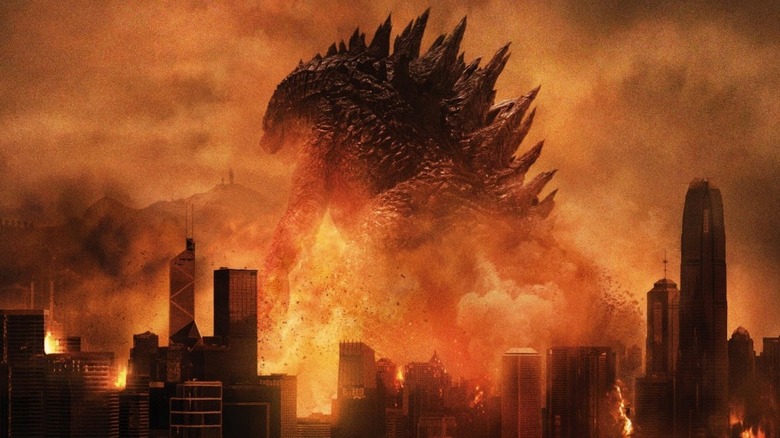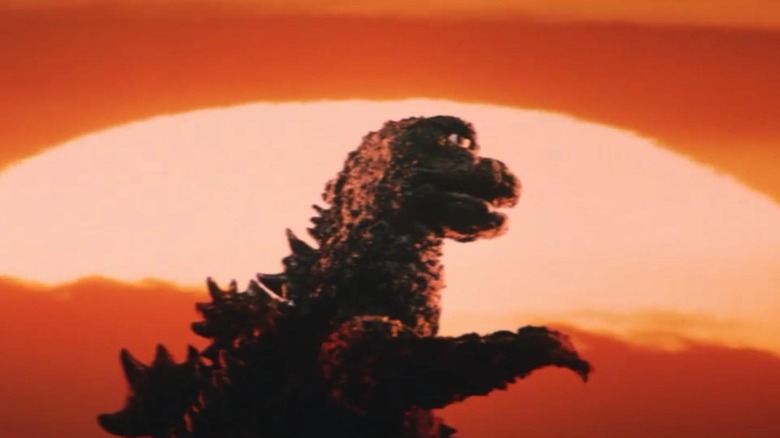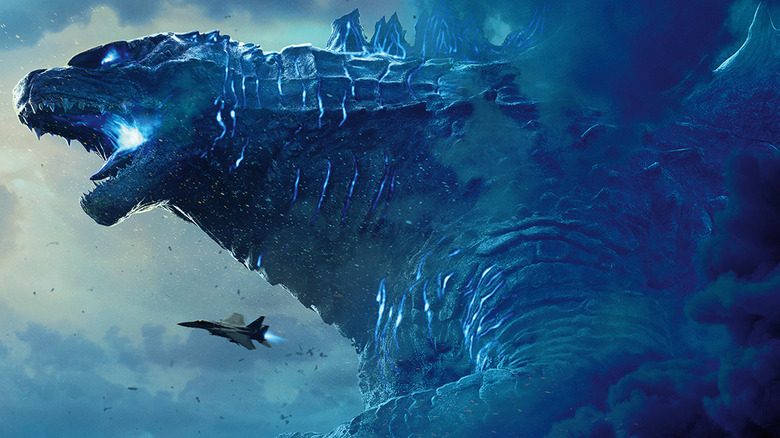The Scrapped Godzilla IMAX Short That Led To The MonsterVerse
Much like any other long-running franchise, "Godzilla" is filled with a great many would-be projects that never managed to see the light of day. Perhaps no scrapped project featuring the King of the Monsters is more consequential than what is most commonly known as "Godzilla 3-D." The film, which was in development in the early 2000s, was going to be a short filmed for IMAX made with American audiences in mind. It never came to be, but development of the project indirectly led to the creation of the MonsterVerse franchise, which kicked off with 2014's "Godzilla" and is still going strong today.
So, how do we go from theatrically-released short film to blockbuster-sized, American-produced theatrical feature? It's an odd, messy journey, and one that is a little heartbreaking in some ways for both fans and one of the franchise's most unique directors. Namely, Yoshimitsu Banno, who helmed 1971's "Godzilla vs. Hedorah," which remains one of the franchise's most bizarre entries to date, yet also one of its most celebrated. The story of this big-budget short film begins with Banno and his desire to once again step behind the camera to tell a tale about Godzilla and the Smog Monster.
For years, Banno had wanted to craft a sequel to "Godzilla vs. Hedorah" but it never came to pass. After "Godzilla: Final Wars" was released in 2004 with disappointing results, Toho decided that they were going to put the franchise to bed for a little while. Banno, who had formed a company called Advanced Audiovisual Productions (AAP), saw an opportunity. During an interview with Godzilla Fans Universe in 2013, Banno explained:
"I first started to produce an IMAX Godzilla movie of only a 40 minute running time, having obtained the permission to use the characters of 'Godzilla' and 'Hedorah' from TOHO. This project developed to a fundamental theatrical movie thanks to the commitment of Legendary Pictures."
A brief history of Godzilla 3-D
Banno's planned short film, which would have been around 40 minutes long, eventually evolved into a feature film once Legendary Pictures came on board as a financial backer/producer. But how did Legendary get involved? And how were Banno's original plans different from what director Gareth Edwards ultimately did with his 2014 film? It's a pretty complicated journey, but let's go over a condensed version of the events.
The folks at Sci-Fi Japan did a rundown of the short's development in 2007. In the early 2000s, Banno cut a deal with Toho that would allow him to create a "Godzilla" short for IMAX. The deal made it clear that Toho wouldn't finance the film, with Banno and his creative partners left to figure that part out themselves. Toho would have approval over the story, character designs, and other elements of the film, and they would also distribute in Japan. AAP would handle sales elsewhere in the world.
Banno's first idea was for a film titled "Godzilla vs. Deathla to the Max," with the story originally completed in 2003. Deathla was, essentially, an evolution of Hedorah, which means this would have taken the place of the sequel that Banno never got to make. The budget, at this time, was expected to be in the $9 million range.
The story would be revised many times in the ensuing years, moving the climactic battle from post-9/11 New York to Las Vegas at one point. The next iteration was titled "Godzilla 3-D to the Max." In 2005, AAP partnered with Whitecat Productions, and a website was launched to attract potential investors. By 2007, the project was still looking for investors but the budget had ballooned to around $25 million.
Legendary Pictures becomes Godzilla 3-D's undoing
In June of 2007, "Godzilla 3-D" was officially announced with "to the Max" dropped from the title, and a company called Kerner Research on board. At the time, they touted what sounded like a rather ambitious entry in the franchise, even though it was going to be just 40 minutes long.
"Godzilla 3-D will be designed to take full advantage of the composition, staging, and dynamic editing of original three dimensional photography. The film will also incorporate updated creature technology along with cutting edge motion capture and 3-D CGI animation to bring a more fluid and realistic energy to Godzilla. This will create more subtle facial moves and will allow the filmmakers to expand and enhance Godzilla's character."
Yet, the project was still in need of financial backers. That eventually led Banno and his team to Legendary Pictures, the company behind such hits as "300" and "The Dark Knight." But this is where Banno's movie as he envisioned it sort of fell apart. Legendary was interested in "Godzilla," but they wanted to produce a feature-length film. In March 2010, it was announced that the company had reached an agreement with Toho to develop a new entry in the franchise, which was to be distributed by Warner Bros.
Banno was credited as an executive producer on 2014's "Godzilla" but it in no way represented what he had in mind while developing his short. "Godzilla 3-D" was dead, and Banno's story ideas were bandoned along the way. What's interesting is that, as late as 2013, Banno was still intent on revisiting his contributions to the franchise. "I am planning the sequel of 'Godzilla vs. the Smog Monster' now," the filmmaker said in that same 2013 interview with Godzilla Fans Universe.
The MonsterVerse gives Godzilla new life
Yoshimitsu Banno passed away in 2017 and never got to see his dream of a "Godzilla vs. Hedorah" sequel realized. But he did, in a roundabout way, help to revive the franchise in a very meaningful way. Gareth Edwards' "Godzilla" may not have resembled Banno's vision, but it was very successful, pulling in $529 million worldwide against a $160 million budget. Yes, the movie proved divisive as it focused a lot on human POV to showcase the monster action, but it was a hit nonetheless. It also, without a doubt, was received far better than America's first attempt at "Godzilla" in 1998, which was both a critical and commercial disaster.
While Edwards didn't stay with the franchise, moving on to make "Rogue One: A Star Wars Story" instead, Legendary and Warner Bros. kept their partnership with Toho alive, releasing several other films over the years including 2017's "Kong: Skull Island," 2018's "Godzilla: King of the Monsters," 2021's "Godzilla vs. Kong," and the Apple TV+ series "Monarch: Legacy of Monsters." Dubbed the MonsterVerse, the franchise had pulled in nearly $2 billion at the box office to date, with "Godzilla x Kong: The New Empire" on the way this year.
Meanwhile, Toho has had success with homegrown entries as well. 2016's "Shin Godzilla" was a massive critical success and a commercial hit in Japan. But it was last year's "Godzilla Minus One" that proved to be one of the most heralded entries in the 70-year history of the franchise, finding huge success at the box office in North America en route to an Oscar nomination for visual effects.
It's the most prosperous time in history for "Godzilla" and it might not have happened if Banno hadn't so aggressively pursued that short film that never came to pass. And if "Godzilla 3-D" had been made, who knows? Maybe the MonsterVerse would've never come to be. For better or worse, Banno helped change the franchise forever.



